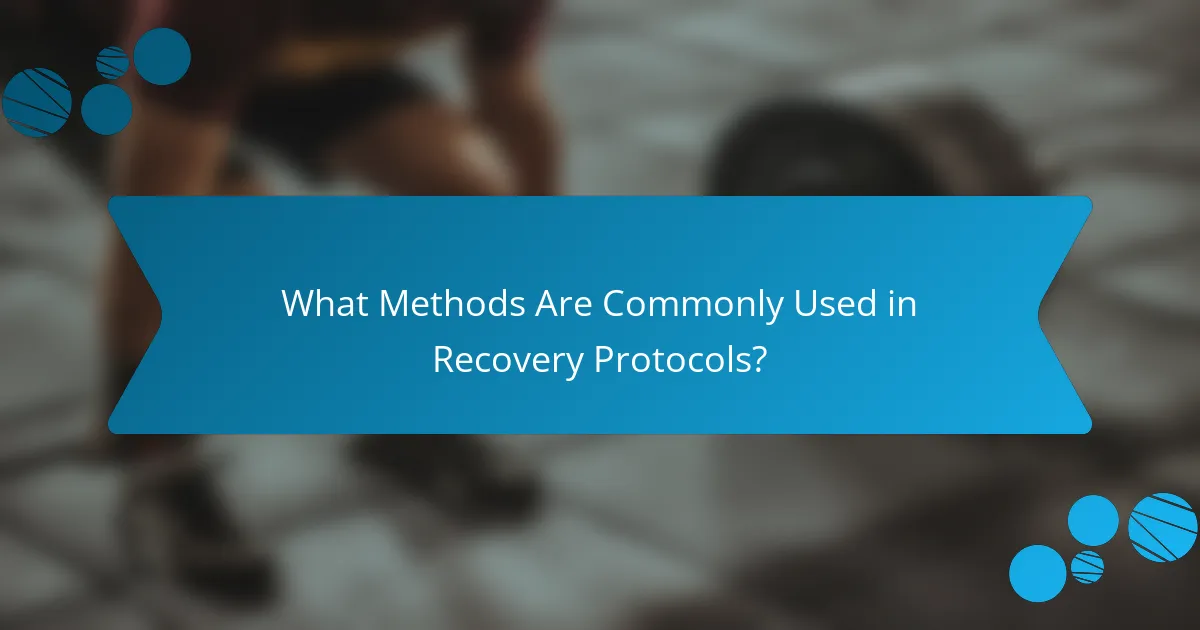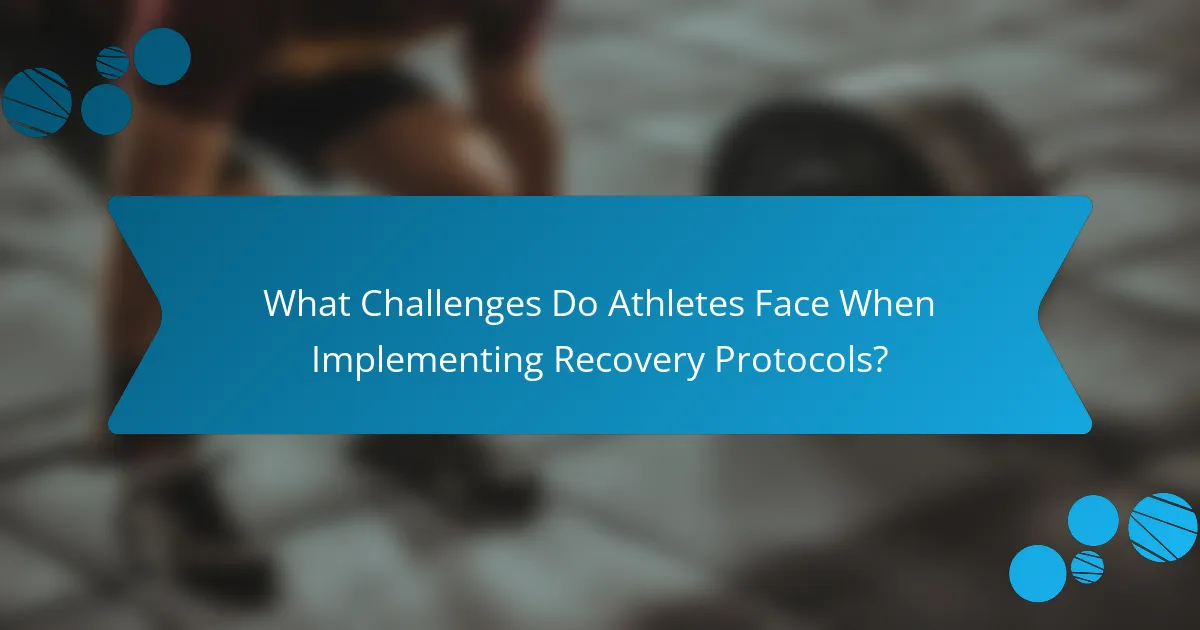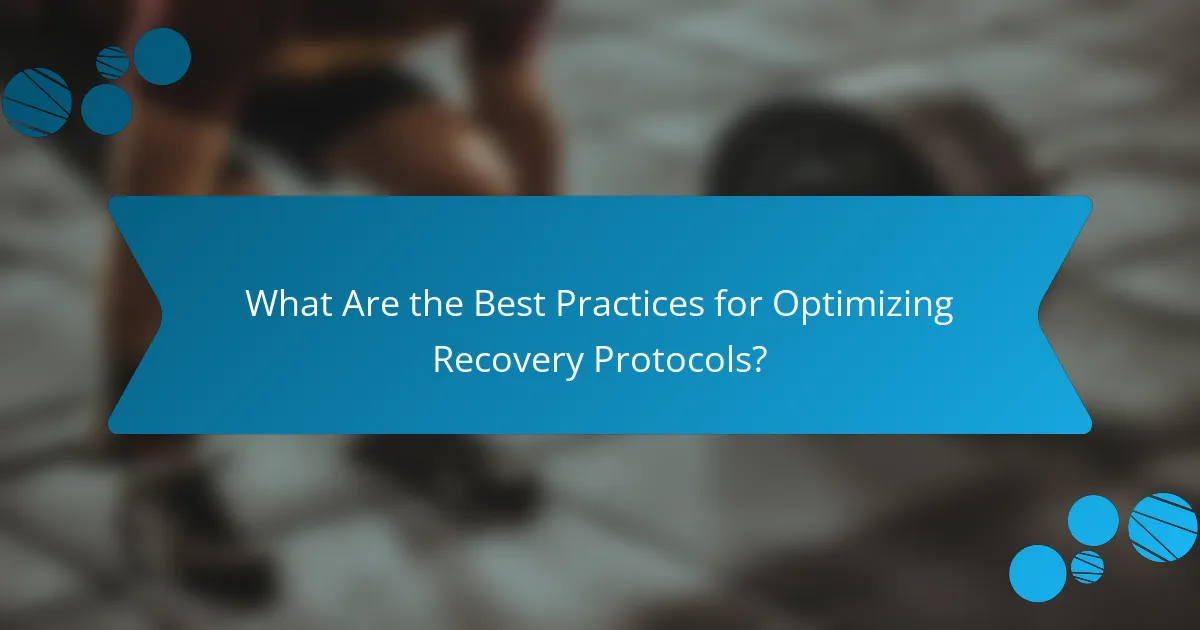Recovery protocols are crucial for athletes, enhancing performance and preventing injuries. This article explores effective recovery methods, including active recovery, nutrition, and rest. It also examines sport-specific variations and the challenges athletes face in implementing these protocols. Finally, innovative trends in recovery for 2025 highlight personalized approaches and advanced technologies.

Why are Recovery Protocols Essential for Athletes?
Recovery protocols are essential for athletes as they enhance performance, prevent injuries, and promote overall well-being. Effective recovery methods include active recovery, hydration, nutrition, and rest. These protocols help reduce muscle soreness and fatigue, allowing athletes to train more effectively. Research indicates that structured recovery can improve athletic output by up to 20%. Prioritizing recovery leads to long-term success and sustainability in sports.
What Physiological Benefits Do Recovery Protocols Provide?
Recovery protocols enhance athletic performance by promoting faster healing, reducing muscle soreness, and improving overall recovery time. These protocols include methods like active recovery, hydration, and nutrition optimization. Active recovery helps maintain blood flow, which accelerates nutrient delivery to muscles. Hydration restores electrolyte balance, crucial for muscle function. Proper nutrition supports tissue repair and energy replenishment. Collectively, these benefits lead to improved performance in subsequent training sessions and competitions.
How Do Recovery Protocols Impact Performance Outcomes?
Recovery protocols significantly enhance athletic performance outcomes by promoting faster recovery and reducing injury risk. Effective methods include active recovery, hydration, nutrition, and sleep optimization. Research shows that structured recovery protocols can improve muscle repair and overall endurance, leading to better performance metrics. For example, athletes utilizing proper recovery techniques report up to a 25% increase in performance efficiency.
Which Psychological Advantages Are Associated with Recovery Protocols?
Recovery protocols provide significant psychological advantages that enhance athletic performance. They promote mental resilience, reduce anxiety, and improve focus during training and competition.
Engaging in structured recovery methods fosters a sense of control and well-being, which can lead to increased motivation. These protocols often include mindfulness practices that help athletes manage stress and maintain a positive mindset.
Additionally, social support during recovery enhances feelings of belonging and reduces feelings of isolation. This communal aspect can strengthen mental fortitude and encourage perseverance through challenges.
Ultimately, the psychological benefits of recovery protocols contribute to improved overall performance, enabling athletes to perform at their best while maintaining mental health.

What Methods Are Commonly Used in Recovery Protocols?
Common methods used in recovery protocols include active recovery, passive recovery, cryotherapy, and nutrition optimization. Each method plays a crucial role in enhancing athletic performance and reducing injury risk.
Active recovery involves low-intensity exercises that promote blood flow and reduce muscle soreness. Passive recovery focuses on rest and relaxation techniques to allow the body to heal. Cryotherapy utilizes cold exposure to reduce inflammation and pain. Nutrition optimization ensures athletes consume the right balance of macronutrients and hydration to support recovery processes.
Incorporating these methods can lead to improved performance and quicker recovery times.
How Does Active Recovery Compare to Passive Recovery?
Active recovery involves low-intensity exercises, while passive recovery focuses on rest. Active recovery can enhance blood flow and reduce muscle soreness, making it beneficial for recovery. Passive recovery, however, allows for complete muscle relaxation and energy restoration. Both methods serve unique purposes in recovery protocols, impacting athletic performance differently. Active recovery is often preferred for its dynamic approach, while passive recovery is essential for intensive recovery periods.
Which Role Does Nutrition Play in Recovery Protocols?
Nutrition plays a crucial role in recovery protocols by providing essential nutrients that facilitate muscle repair and energy replenishment. Proper nutrition enhances recovery speed and improves overall athletic performance. Key components include proteins for muscle synthesis, carbohydrates for glycogen replenishment, and healthy fats for inflammation reduction. Hydration is also vital, as it supports metabolic processes and nutrient transport. Incorporating a balanced diet tailored to individual needs can optimize recovery outcomes.
What Are the Benefits of Sleep in Recovery Protocols?
Sleep significantly enhances recovery protocols by improving muscle repair, hormone regulation, and cognitive function. Adequate sleep allows the body to recover from physical exertion, reducing the risk of injury and enhancing overall athletic performance. Research shows that athletes who prioritize sleep experience better endurance and strength gains. Sleep also plays a critical role in reducing inflammation and supporting immune function, which are essential for optimal recovery.
How Can Technology Enhance Recovery Protocols?
Technology enhances recovery protocols by providing data-driven insights and personalized approaches. Wearable devices track biometrics, enabling athletes to monitor their recovery progress in real-time. Virtual reality can simulate recovery environments, reducing anxiety and improving mental health. Additionally, apps facilitate tailored recovery plans based on individual performance metrics. These advancements lead to more effective recovery strategies and ultimately enhance athletic performance.

How Do Recovery Protocols Vary Across Different Sports?
Recovery protocols vary significantly across sports, reflecting the unique demands of each discipline. Endurance sports like marathon running emphasize hydration and nutrition recovery, while strength sports focus on muscle repair through protein intake and rest.
In team sports, recovery often incorporates active recovery techniques, such as light exercises or stretching, to maintain mobility. Sports like gymnastics prioritize flexibility and joint care, leading to different protocols involving targeted stretching routines.
Additionally, the use of technology, such as cryotherapy or compression garments, differs by sport, with some athletes adopting these methods to enhance recovery speed and reduce injury risk.
Overall, tailored recovery protocols are essential for optimizing performance and minimizing downtime, demonstrating the importance of sport-specific strategies in athletic recovery.
What Unique Recovery Needs Do Endurance Athletes Have?
Endurance athletes have unique recovery needs that focus on muscle repair, hydration, and energy replenishment. These athletes often require tailored recovery protocols to optimize performance and prevent injury. Effective methods include active recovery, nutrition strategies, and adequate sleep. For instance, incorporating protein and carbohydrates post-exercise aids muscle recovery. Hydration strategies, such as electrolyte replenishment, are crucial for maintaining performance. Additionally, techniques like foam rolling and stretching help reduce muscle soreness and improve flexibility.
How Do Team Sports Differ in Recovery Protocols?
Team sports often differ in recovery protocols due to varying physical demands and team structures. Recovery protocols in team sports typically emphasize hydration, nutrition, and rest, tailored to the specific needs of athletes. For instance, sports like soccer may focus on active recovery through light training, while basketball might prioritize ice baths for muscle recovery. The effectiveness of these protocols can significantly impact athletic performance, with proper recovery leading to reduced injury risk and enhanced endurance.
Which Recovery Protocols Are Most Effective for Strength Training?
Active recovery, adequate sleep, and nutrition are the most effective recovery protocols for strength training. Active recovery, such as light aerobic exercise, promotes blood flow and reduces muscle soreness. Sleep is crucial for muscle repair and hormonal balance, with 7-9 hours recommended. Proper nutrition, including protein intake, aids in muscle recovery and growth. Combining these methods enhances athletic performance and reduces injury risk.

What Challenges Do Athletes Face When Implementing Recovery Protocols?
Athletes face several challenges when implementing recovery protocols. These include time constraints, varying individual needs, and access to resources.
Time constraints can limit the ability to follow recovery protocols consistently. Athletes often juggle training, competitions, and personal commitments, making it difficult to prioritize recovery.
Individual needs vary significantly among athletes. Factors such as age, type of sport, and injury history influence the effectiveness of specific recovery methods.
Access to resources is another challenge. Not all athletes have access to advanced recovery technologies or professional guidance, which can hinder their recovery efforts.
Finally, adherence to protocols can be inconsistent, as athletes may struggle with motivation or understanding the importance of recovery in enhancing performance.
How Can Time Constraints Affect Recovery Protocols?
Time constraints can significantly hinder recovery protocols, impacting athletic performance. Limited recovery time reduces the effectiveness of rest, rehabilitation, and nutrition, leading to potential injuries and decreased performance levels. Athletes may struggle to fully recuperate, affecting their physical and mental readiness for competition. Additionally, inadequate recovery can impair muscle repair and adaptation processes, ultimately compromising overall athletic development. Prioritizing efficient recovery strategies is essential for optimizing performance within tight schedules.
What Are Common Misconceptions About Recovery Protocols?
Many misconceptions exist about recovery protocols, often leading to ineffective practices. One common belief is that rest alone suffices for recovery, ignoring active recovery methods that enhance performance. Another misconception is that all athletes require the same recovery strategies; individual needs vary based on factors like intensity and type of training. Additionally, some think that longer recovery times are always better, while optimal recovery can be achieved within shorter periods when tailored correctly. Lastly, the idea that nutrition is secondary to recovery overlooks its critical role in muscle repair and overall performance enhancement.
How Can Access to Resources Impact Recovery Protocols?
Access to resources significantly enhances recovery protocols by providing athletes with essential tools and support. Adequate access to facilities, medical professionals, and nutritional guidance accelerates healing and improves performance outcomes. Studies show that athletes with comprehensive recovery resources experience faster recovery times and reduced injury rates. Furthermore, individualized recovery plans, supported by expert advice and quality equipment, lead to optimal athletic performance and longevity in sports.

What Are Innovative Trends in Recovery Protocols for 2025?
Innovative trends in recovery protocols for 2025 focus on personalized approaches, advanced technology, and holistic methods. These trends aim to enhance athletic performance and optimize recovery times.
1. Personalized Recovery Plans: Utilizing data analytics and wearable technology, athletes receive tailored recovery strategies based on individual needs and performance metrics.
2. Integration of AI: Artificial intelligence analyzes recovery patterns and suggests optimal protocols, improving efficiency and effectiveness in recovery routines.
3. Mental Recovery Techniques: Emphasizing the psychological aspect of recovery, practices such as mindfulness and visualization are gaining traction to support overall athlete well-being.
4. Nutritional Innovations: Advances in nutrition science lead to specialized recovery diets and supplements that enhance muscle repair and reduce inflammation.
5. Cryotherapy and Hydrotherapy: These methods are increasingly utilized for reducing muscle soreness and promoting faster recovery, showcasing their effectiveness in athletic training.
6. Community and Support Systems: Building strong support networks enhances mental resilience, contributing to improved recovery outcomes for athletes.
How Are Personalized Recovery Protocols Changing the Landscape?
Personalized recovery protocols are significantly enhancing athletic performance by tailoring recovery strategies to individual needs. These protocols consider unique factors such as injury history, training intensity, and personal recovery responses. As a result, athletes experience improved recovery times, reduced injury rates, and optimized performance outcomes. Personalized approaches also incorporate advanced technologies, such as wearable devices, to monitor recovery metrics in real-time, ensuring that athletes can adapt their training effectively. This shift towards individualized care marks a transformative change in sports recovery practices.
Which Emerging Technologies Are Shaping Future Recovery Protocols?
Emerging technologies shaping future recovery protocols include wearables, AI-driven analytics, and regenerative medicine. These innovations enhance monitoring, personalize recovery, and expedite healing processes. Wearables provide real-time data on physiological metrics, while AI analyzes this data to optimize recovery strategies. Regenerative medicine, including stem cell therapy, offers unique solutions for injury recovery, making protocols more effective.
What Role Does Mental Health Play in Future Recovery Strategies?
Mental health is crucial in shaping effective recovery strategies for athletes. It influences resilience, motivation, and the ability to cope with setbacks. A strong mental state enhances focus and reduces anxiety, leading to improved performance. Integrating mental health support into recovery protocols can optimize physical healing processes and promote overall well-being. As a result, athletes are more likely to adhere to recovery plans, facilitating quicker and more effective returns to their sport.

What Are the Best Practices for Optimizing Recovery Protocols?
To optimize recovery protocols, focus on individualized plans, hydration, nutrition, and active recovery techniques. Incorporating rest days and monitoring performance metrics enhances effectiveness. These practices facilitate muscle repair, reduce injury risk, and improve overall athletic performance.
How Can Athletes Monitor Their Recovery Effectively?
Athletes can effectively monitor their recovery by utilizing various protocols that include tracking physiological metrics, employing recovery technologies, and implementing structured rest periods. Regularly assessing heart rate variability, sleep quality, and muscle soreness provides valuable insights into recovery status.
Incorporating methods such as active recovery, hydration strategies, and nutritional support enhances overall recovery effectiveness. For instance, using wearable technology can help athletes gather real-time data on their recovery process, allowing for timely adjustments to training loads.
Moreover, understanding the effects of recovery on athletic performance is crucial. Adequate recovery leads to improved strength, endurance, and overall performance, while neglecting recovery can result in fatigue and increased injury risk.
By prioritizing recovery protocols, athletes can optimize their training outcomes and maintain peak performance levels.
What Common Mistakes Should Athletes Avoid in Recovery Protocols?
Athletes should avoid common mistakes in recovery protocols to enhance performance and prevent injuries. Key errors include neglecting hydration, skipping cool-down exercises, underestimating rest duration, and ignoring nutrition.
1. Neglecting hydration can lead to decreased performance and longer recovery times.
2. Skipping cool-down exercises may increase muscle soreness and stiffness.
3. Underestimating rest duration can result in overtraining and injuries.
4. Ignoring nutrition affects muscle repair and overall recovery efficiency.
By addressing these mistakes, athletes can optimize their recovery and improve their athletic performance.
Which Strategies Can Enhance the Effectiveness of Recovery Protocols?
Implementing varied recovery strategies significantly enhances recovery protocol effectiveness. Key strategies include active recovery, hydration, nutrition, and sleep optimization.
Active recovery promotes blood flow, reducing muscle soreness. Hydration replenishes fluids lost during exercise, aiding overall recovery. Proper nutrition, including protein intake, supports muscle repair. Quality sleep enhances hormonal balance and overall recovery efficiency.
Incorporating these strategies leads to improved athletic performance and reduced injury risk.